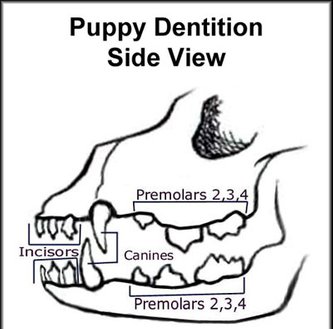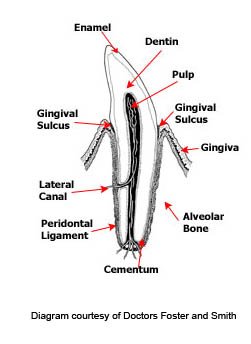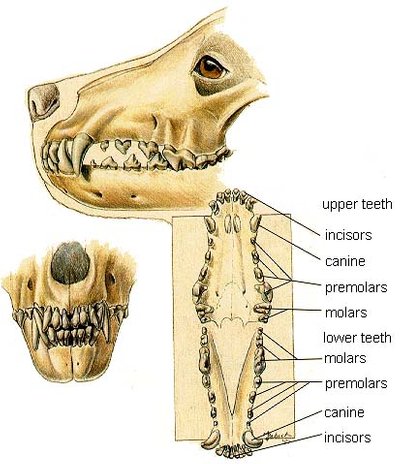YOUR DOGS TEETH
Echuca Daredevil And Dashing Bamse is showing his puppyteeth
Just as us humans dogs have two sets of teeth, baby-teeth, and adult-teeth.
Puppies are born without teeth. They do not receive their first puppy teeth until they reach the age of between two or three weeks young. They grow a total of 28 teeth, which are known as baby teeth. The first teeth that fall out are the incisor teeth, followed by the premolars and the canines.
Puppies do not have molar teeth, only premolars. As adults they have 42 teeth and they arrive about four to seven/eight months.
Teething
For puppies, the teething process continues for several months, off and on. For a puppy, this can be an uncomfortable and also a bit painful period.
When puppies are teething, they increase their biting and chewing and test out different objects and texture to relieve the discomfort.
Here you can wet at towel, put it in the freezer and then give it to your puppy frozen, that often soothes its mouth. These first teeth are small, and painfully sharp, like needles.
Losing Teeth
Each baby tooth root will generally be absorbed by the adult tooth.
The first teeth that fall out is the incisors, then the adult molars and adult canines are beginning to come in, then the adult molars will come in. Finally, by seven to eight months, the full set of adult teeth should have come in.
Are the Adult Teeth Coming in Normally?
Just as you should begin an at-home dental care program as soon as you get your new puppy, this is also the time we recommend you start observing his/hers teeth to make sure they are coming in normally. Any baby teeth that don’t fall out to make way for the adult teeth are called retained baby teeth. Having two teeth
crowded into a space meant for one can cause dental problems.
Food can get caught between the teeth and cause periodontal disease. The pressure from the retained baby tooth can push the adult tooth into an abnormal position, where it may push against the lip or gum causing an ulcer, or prevent the upper and lower teeth from coming together properly, which may cause chewing problems.
Retained baby teeth need to be removed surgically. Ideally, this should be done as soon as they are noticed, so that the adult tooth has the best chance of coming in normally.
Tooth deficiency
Research shows that perhaps 40% of all dogs is missing one or more teeth. Tooth deficiency with the dog has been around for thousands of years. A dog may lose a tooth while growing up, the tooth can be there, but it has not broken through the gums, but most tooth deficiency is hereditary.
Correct bite
Scissor bite is the dog's normal bite and the bite one wants on the vast majority of the races. When the dog has a scissor bite form, the teeth in the upper jaw is placed directly in front of the front teeth in the lower jaw. The tooth rows are so close together that they are in contact with each other, but they do not meet. The teeth in the lower jaw corner sticking up right in front of corner teeth in the upper jaw.
Loose teeth
For puppies, loose teeth aren't a problem. You may even find some cast-off ones in his/hers bedding or around the house. By the time he's about 7 or 8 months old, he/she should well on his way to sporting a new set of 42 adult teeth.
While all this activity is going on, periodically check inside your puppy's mouth.
For an adult dog, a loose tooth is more suspect. It usually results from trauma to the mouth or from gum loss due to advanced periodontal disease. It may also be a sign of illness.
Visit your vet if your adult dog has a loose tooth.
Some teeth and mouth diseases to be aware of :
Periodontal disease: is a painful infection between the tooth and the gum that can result in tooth loss and spread infection to the rest of the body. Signs are loose teeth, bad breath, tooth pain, sneezing and nasal discharge.
Gingivitis: is an inflammation of the gums caused mainly by accumulation of plaque, tartar and disease-producing bacteria above and below the gum line. Signs include bleeding, red, swollen gums and bad breath. It is reversible with regular teeth cleanings
Halitosis / or bad breath: can be the first sign of a mouth problem and is caused by bacteria growing from food particles caught between the teeth or by gum infection. Regular tooth-brushings are a great solution.
Swollen gums: develop when tartar builds up and food gets stuck between the teeth. Regularly brushing your dog's teeth at home and getting annual cleanings at the vet can prevent tartar and gingivitis
Proliferating gum disease: occurs when the gum grows over the teeth and must be treated to avoid gum infection. An inherited condition common to boxers and bull terriers, it can be treated with antibiotics
Mouth tumors: appear as lumps in the gums. Some are malignant and must be surgically removed.
Salivary cysts: look like large, fluid-filled blisters under the tongue, but can also develop near the corners of the jaw. They require drainage, and the damaged saliva gland must be removed.
Canine distemper teeth: can occur if a dog had distemper as a puppy. Adult teeth can appear looking eroded and can often decay. As damage is permanent, decayed teeth should be removed by a veterinarian




